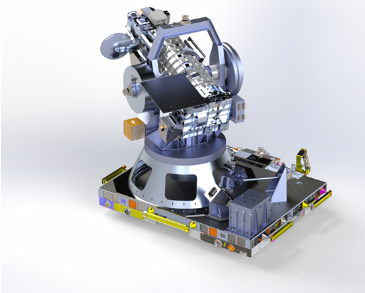The payload is mounted to the ISS-supplied FRAM, which provides all electrical (power, data) and mechanical interfaces to the ISS.
CODEX subsystems include the coronagraph, pointing system, and power distribution unit.
The coronagraph design consists of a modular aluminum structure, aperture door mechanism, optical assembly, filter wheel assembly, focal plane assembly, thermal radiator, and command and data handling electronics.
The optical assembly consists of the lens groups, including objective and field lenses, external occulter, internal occulter, focal mask, heat rejection mirror (HRM) that reflects disk light out of system, and folding mirrors.
Unlike BITSE, CODEX has an internal occulter as traditional multi-stage coronagraphs.
However, a number of adjustments in the design from traditional externally occulted coronagraphs have been made to reduce diffraction and vignetting at the inner field of view.
Folding mirrors were introduced to fit in the allocated volume.
Two folding mirrors were used to minimize the polarization change.
The mechanical structure consists of a series of conventionally machined aluminum sections bolted and pinned together for alignment stability.
To reduce stray light, each section is bead blasted and black anodized, and the front tube section has a series of integral knife-edge baffles.
The camera is mounted onto the aft section of the assembly and a thermal radiator is used to cool the camera.
The coronagraph itself has only three mechanisms: an aperture door and two filterwheel rotators.
The motorized aperture door prevents contamination of the interior surfaces and optics.
The CODEX pointing system is designed to meet the requirements of the science instrument for stable solar observations conducted from the moving ISS platform.
The system uses high-heritage components including a sun sensor, star tracker, gimbals, and software that enable the CODEX to track the sun as the ISS orbits the Earth.
The poinying system must suppress pitch and yaw jitter to less than 11.25 arcsec (3σ) over a ~60 sec exposure, and also keep the instrument bore-sight to within 30 arcsec (3σ) of the Sun center.
The system utilizes a two-axis gimbal system with azimuth and elevation stages.
A Blue Canyon Technologies Nano Star Tracker is mounted to the FRAM for providing precise roll knowledge down to 13 arcmin.
The system is balanced so the center of gravity of the pointed mass is co-located at the center of rotation for the gimbals to mitigate disturbance torques produced by translational accelerations at the instrument mount.
An active latch mechanism restrains the coronagraph assembly during launch and on-station storage.
The High-rate Fine Sun Sensor (HFSS) serves as the primary sensor for position feedback.
This sensor is currently being used for pointing the Total and Spectral Irradiance Sensor (TSIS) experiment on ISS.
A SpaceCube Mini is used as the main electronics in the pointing system, likewise in the coronogragh.




